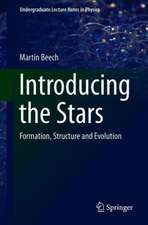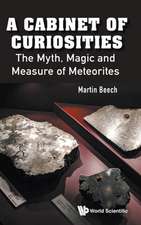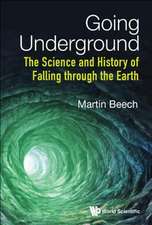Rejuvenating the Sun and Avoiding Other Global Catastrophes: Astronomers' Universe
Autor Martin Beechen Limba Engleză Paperback – 10 dec 2007
Din seria Astronomers' Universe
-
 Preț: 210.44 lei
Preț: 210.44 lei -
 Preț: 207.15 lei
Preț: 207.15 lei -
 Preț: 195.53 lei
Preț: 195.53 lei -
 Preț: 254.90 lei
Preț: 254.90 lei -
 Preț: 284.56 lei
Preț: 284.56 lei -
 Preț: 212.88 lei
Preț: 212.88 lei -
 Preț: 256.41 lei
Preț: 256.41 lei -
 Preț: 264.35 lei
Preț: 264.35 lei -
 Preț: 259.08 lei
Preț: 259.08 lei -
 Preț: 227.61 lei
Preț: 227.61 lei -
 Preț: 277.98 lei
Preț: 277.98 lei -
 Preț: 305.70 lei
Preț: 305.70 lei -
 Preț: 253.11 lei
Preț: 253.11 lei -
 Preț: 216.60 lei
Preț: 216.60 lei -
 Preț: 272.24 lei
Preț: 272.24 lei -
 Preț: 330.75 lei
Preț: 330.75 lei -
 Preț: 179.00 lei
Preț: 179.00 lei -
 Preț: 289.83 lei
Preț: 289.83 lei -
 Preț: 160.03 lei
Preț: 160.03 lei -
 Preț: 200.80 lei
Preț: 200.80 lei -
 Preț: 255.97 lei
Preț: 255.97 lei -
 Preț: 242.58 lei
Preț: 242.58 lei -
 Preț: 262.55 lei
Preț: 262.55 lei -
 Preț: 282.38 lei
Preț: 282.38 lei -
 Preț: 187.82 lei
Preț: 187.82 lei -
 Preț: 225.19 lei
Preț: 225.19 lei -
 Preț: 207.64 lei
Preț: 207.64 lei -
 Preț: 104.35 lei
Preț: 104.35 lei -
 Preț: 188.94 lei
Preț: 188.94 lei -
 Preț: 270.50 lei
Preț: 270.50 lei -
 Preț: 212.01 lei
Preț: 212.01 lei -
 Preț: 169.08 lei
Preț: 169.08 lei -
 Preț: 210.01 lei
Preț: 210.01 lei -
 Preț: 208.26 lei
Preț: 208.26 lei -
 Preț: 253.98 lei
Preț: 253.98 lei -
 Preț: 180.12 lei
Preț: 180.12 lei -
 Preț: 280.19 lei
Preț: 280.19 lei -
 Preț: 273.13 lei
Preț: 273.13 lei -
 Preț: 207.39 lei
Preț: 207.39 lei -
 Preț: 208.70 lei
Preț: 208.70 lei -
 Preț: 214.86 lei
Preț: 214.86 lei -
 Preț: 188.94 lei
Preț: 188.94 lei -
 Preț: 194.65 lei
Preț: 194.65 lei -
 Preț: 277.34 lei
Preț: 277.34 lei -
 Preț: 210.93 lei
Preț: 210.93 lei -
 Preț: 212.01 lei
Preț: 212.01 lei
Preț: 187.15 lei
Nou
Puncte Express: 281
Preț estimativ în valută:
35.82€ • 37.25$ • 29.57£
35.82€ • 37.25$ • 29.57£
Carte disponibilă
Livrare economică 24 martie-07 aprilie
Preluare comenzi: 021 569.72.76
Specificații
ISBN-13: 9780387681283
ISBN-10: 0387681280
Pagini: 225
Ilustrații: XII, 228 p. 40 illus.
Dimensiuni: 155 x 235 x 11 mm
Greutate: 0.42 kg
Ediția:2008
Editura: Springer
Colecția Springer
Seria Astronomers' Universe
Locul publicării:New York, NY, United States
ISBN-10: 0387681280
Pagini: 225
Ilustrații: XII, 228 p. 40 illus.
Dimensiuni: 155 x 235 x 11 mm
Greutate: 0.42 kg
Ediția:2008
Editura: Springer
Colecția Springer
Seria Astronomers' Universe
Locul publicării:New York, NY, United States
Public țintă
Professional/practitionerCuprins
A Universal Problem.- It’s a Matter of Time.- The Sun, Inside and Out.- The Price of Doing Nothing.- Rejuvenating the Sun.- Stars Transformed.- Between Now and Then.
Recenzii
From the reviews:
"In this book based on several of his previously published scientific articles, Beech … investigates the idea that the evolution of the sun can be controlled. … the book offers much fascinating material on extraterrestrial life and provides an interesting discussion of why extraterrestrials have never visited Earth. … Each chapter ends with extensive notes and references. Summing Up: Recommended. General readers; lower-division undergraduates through researchers." (B. R. Parker, CHOICE, Vol. 45 (10), June, 2008)
"Beech takes great care and time to fully describe the workings of the Sun. As a grounding in solar astrophysics this is an excellent read and even if we do not know exactly how we could engineer our Sun at the present time, it is a useful thought experiment to better understand how our Sun operates. … Add to this some interesting insights into SETI, Solar System colonisation and humanity’s near future, and you have a very thought-provoking book." (Keith Cooper, Astronomy Now, July, 2008)
"If you have ever mused over what will become of Mother Earth when the Sun evolves away from the main sequence, here is a book to carry you further into the realms of futuristic science than you have probably hitherto visited. … The book discusses the probabilities and devastation levels of known celestial-based disasters from supernovae to large meteorites. … Beech writes well, with a slight whimsical humour … he offers a comfortable read." (Elizabeth Griffin, The Observatory, Vol. 128 (1206), October, 2008)
"In this book based on several of his previously published scientific articles, Beech … investigates the idea that the evolution of the sun can be controlled. … the book offers much fascinating material on extraterrestrial life and provides an interesting discussion of why extraterrestrials have never visited Earth. … Each chapter ends with extensive notes and references. Summing Up: Recommended. General readers; lower-division undergraduates through researchers." (B. R. Parker, CHOICE, Vol. 45 (10), June, 2008)
"Beech takes great care and time to fully describe the workings of the Sun. As a grounding in solar astrophysics this is an excellent read and even if we do not know exactly how we could engineer our Sun at the present time, it is a useful thought experiment to better understand how our Sun operates. … Add to this some interesting insights into SETI, Solar System colonisation and humanity’s near future, and you have a very thought-provoking book." (Keith Cooper, Astronomy Now, July, 2008)
"If you have ever mused over what will become of Mother Earth when the Sun evolves away from the main sequence, here is a book to carry you further into the realms of futuristic science than you have probably hitherto visited. … The book discusses the probabilities and devastation levels of known celestial-based disasters from supernovae to large meteorites. … Beech writes well, with a slight whimsical humour … he offers a comfortable read." (Elizabeth Griffin, The Observatory, Vol. 128 (1206), October, 2008)
Notă biografică
Associate professor of astronomy, and Head of the Astronomy Department at Campion College, The University of Regina. My main research interests during the past decade have focused on the smaller objects within the solar system (comets, asteroids and meteoroids), but concomitant to this I have continued to perform research related to the structure and evolution of stars (the area of my doctoral studies). The book being proposed here is partly based upon a series of research papers that I have published over the years and on material used in a solar system studies class. The topic of asteroengineering was recently the focus of an ‘opinion article’ I wrote for the May 2006 issue of Astronomy Now magazine, and an editorial piece in the May 2006 issue of Smithsonian Air and Space magazine.
Home web page: http://hyperion.cc.uregina.ca/~astro/mbeech.html
Home web page: http://hyperion.cc.uregina.ca/~astro/mbeech.html
Textul de pe ultima copertă
Our Sun is aging. Like us, it will someday die, and the light that warms and illuminates our planet will go out. All life on Earth will perish with it—unless we do something to stop it.
Is that possible? Martin Beech thinks it is, but we must begin to plan and create the technologies that will save us NOW!
Of course, we do not expect the Sun’s demise to happen anytime soon. The Sun is only about halfway through its expected lifetime. We are talking about an event that will not take place for billions of years. But it may take that long to engineer (actually, asteroengineer) our way out of the crisis. And in the meantime, we can use the newly developed knowledge and technologies to protect us from more immediate threats, such as asteroid and comet hits, global warming, and mass extinctions.
For us to keep the Sun shining, we must first change our attitudes. We must put profit and short-term thinking aside. And we must come together to share the risks and costs of the necessary endeavors. Martin Beech will lay out for you, in startling clear and compelling fashion, some basic star science, what the issues are, and how you can join in this massive undertaking to prevent global disaster and keep us in the Sun’s life-giving light for the foreseeable future.
Is that possible? Martin Beech thinks it is, but we must begin to plan and create the technologies that will save us NOW!
Of course, we do not expect the Sun’s demise to happen anytime soon. The Sun is only about halfway through its expected lifetime. We are talking about an event that will not take place for billions of years. But it may take that long to engineer (actually, asteroengineer) our way out of the crisis. And in the meantime, we can use the newly developed knowledge and technologies to protect us from more immediate threats, such as asteroid and comet hits, global warming, and mass extinctions.
For us to keep the Sun shining, we must first change our attitudes. We must put profit and short-term thinking aside. And we must come together to share the risks and costs of the necessary endeavors. Martin Beech will lay out for you, in startling clear and compelling fashion, some basic star science, what the issues are, and how you can join in this massive undertaking to prevent global disaster and keep us in the Sun’s life-giving light for the foreseeable future.
Caracteristici
Brings together, for the first time, the ideas related to the physical engineering of our Sun in order to promote the long-term survival of humanity and the Earth itself Starting with the ideas currently being promoted for planetary defence against impacting comets and asteroids this book considers the other, more distant astronomical phenomena (supernova explosions, close passing ‘rogue’ stars, and gamma-ray bursts) that pose a long-term threat to life on Earth lacing asteroengineering in a galactic context, this book describes one of the most important and lethal astronomical problems, that of an aging parent star, which all extraterrestrial civilizations will eventually have to face Includes supplementary material: sn.pub/extras


























